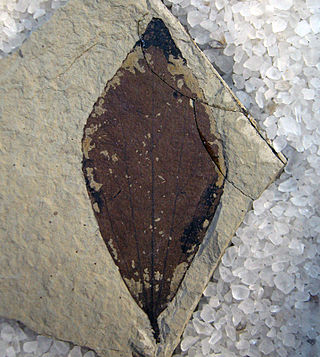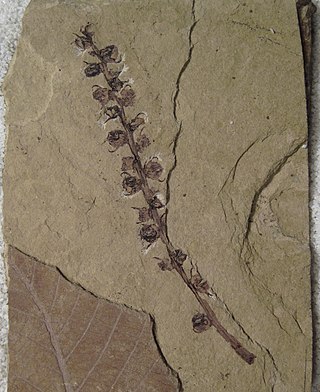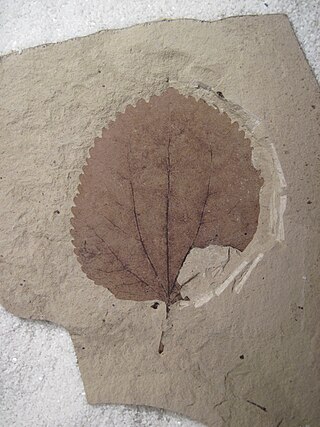
Saxifragales is an order of angiosperms, or flowering plants, containing 15 botanical families and around 100 genera, with nearly 2,500 species. Of the 15 families, many are small, with eight of them being monotypic. The largest family is the Crassulaceae (stonecrops), a diverse group of mostly succulent plants, with about 35 genera. Saxifragales are found worldwide, primarily in temperate to subtropical zones, rarely being encountered growing wild in the tropics; however, many species are now cultivated throughout the world as knowledge of plant husbandry has improved. They can be found in a wide variety of environments, from deserts to fully aquatic habitats, with species adapted to alpine, forested or fully-aquatic habitats. Many are epiphytic or lithophytic, growing on exposed cliff faces, on trees or on rocks, and not requiring a highly organic or nutrient-dense substrate to thrive.

The Elaeagnaceae are a plant family, the oleaster family, of the order Rosales comprising small trees and shrubs, native to temperate regions of the Northern Hemisphere, south into tropical Asia and Australia. The family has about 60 species in three genera.

Menispermaceae is a family of flowering plants. The alkaloid tubocurarine, a neuromuscular blocker and the active ingredient in the 'tube curare' form of the dart poison curare, is derived from the South American liana Chondrodendron tomentosum. Several other South American genera belonging to the family have been used to prepare the 'pot' and 'calabash' forms of curare. The family contains 78 genera with some 440 species, which are distributed throughout low-lying tropical areas with some species present in temperate and arid regions.

Trochodendron is a genus of flowering plants with one living species, Trochodendron aralioides, and six extinct species known from the fossil record. It was often considered the sole genus in the family Trochodendraceae, though botanists now also include the distinct genus Tetracentron in the family.

Trochodendraceae is the only family of flowering plants in the order Trochodendrales. It comprises two extant genera, each with a single species along with up to five additional extinct genera and a number of extinct species. The living species are native to south east Asia. The two living species both have secondary xylem without vessel elements, which is quite rare in angiosperms. As the vessel-free wood suggests primitiveness, these two species have attracted much taxonomic attention.

Didymeles is a genus of flowering plants. It is variously treated as the only genus of the family Didymelaceae — or in the family Buxaceae, as in the APG IV system.

Tetracentron sinense is a flowering plant native to Asia and the sole living species in the genus Tetracentron. It was formerly considered the sole species in the family Tetracentraceae, though Tetracentron is now included in the family Trochodendraceae together with the genus Trochodendron.

Trochodendron aralioides, sometimes colloquially called wheel tree, is a flowering plant and the sole living species in the genus Trochodendron, which also includes several extinct species. It was also often considered the sole species in the family Trochodendraceae, though botanists now include the distinct genus Tetracentron in the same family. T. aralioides is native to Japan, southern Korea and Taiwan. Growing in lower temperate montane mixed forests in Japan, and broad-leaved evergreen forest in the central mountain ranges and Northern parts of Taiwan.
Paleontology or palaeontology is the study of prehistoric life forms on Earth through the examination of plant and animal fossils. This includes the study of body fossils, tracks (ichnites), burrows, cast-off parts, fossilised feces (coprolites), palynomorphs and chemical residues. Because humans have encountered fossils for millennia, paleontology has a long history both before and after becoming formalized as a science. This article records significant discoveries and events related to paleontology that occurred or were published in the year 1926.

Trochodendron nastae is an extinct species of flowering plant in the family Trochodendraceae known from fossil leaves found in the early Eocene Ypresian stage Klondike Mountain Formation deposits of northern Washington state. T. nastae is one of the oldest members of the genus Trochodendron, which includes the living species T. aralioides, native to Japan, southern Korea and Taiwan and the coeval extinct species T. drachukii from the McAbee Fossil Beds near Cache Creek, British Columbia.
Trochodendron drachukii is an extinct species of flowering plants in the family Trochodendraceae known from a fossil fruiting structure found in the early Ypresian age Eocene fossils found in British Columbia, Canada. T. drachukii is one of the oldest members of the genus Trochodendron, which includes the living species T. aralioides, native to Japan, southern Korea and Taiwan and the coeval extinct species T. nastae from Washington state, United States.

Tsukada is an extinct genus of flowering plant in the family Nyssaceae related to the modern "dove-tree", Davidia involucrata, containing the single species Tsukada davidiifolia. The genus is known from fossil leaves found in the early Eocene deposits of northern Washington state, United States and a similar aged formation in British Columbia, Canada.
Concavistylon is an extinct genus of flowering plant in the family Trochodendraceae comprising a single species Concavistylon kvacekii. The genus is known from fossils found in Middle Miocene deposits of central Oregon. A second species "Concavistylon" wehrii was originally placed in Concavistylon, but subsequently moved to a new genus Paraconcavistylon in 2020.

Pentacentron is an extinct genus of flowering plant in the family Trochodendraceae, consisting of the single species Pentacentron sternhartae. The genus is known from fossil fruits found in the early Eocene deposits of northern Washington state, United States. P. sternhartae are possibly the fruits belonging to the extinct trochodendraceous leaves Tetracentron hopkinsii.

Tetracentron hopkinsii is an extinct species of flowering plant in the family Trochodendraceae. The species is known from fossil leaves found in the early Eocene deposits of northern Washington state, United States and south Central British Columbia. The species was first described from fossil leaves found in the Allenby Formation. T. hopkinsii are possibly the leaves belonging to the extinct trochodendraceous fruits Pentacentron sternhartae.
Trochodendron postnastae is an extinct species of flowering plant in the family Trochodendraceae. The species is known from fossils found in Middle Miocene deposits of central Oregon. T. postnastae are possibly the leaves belonging to the extinct trochodendraceous fruits Trochodendron rosayi.
Trochodendron rosayi is an extinct species of flowering plant in the family Trochodendraceae. The species is known from fossils found in Middle Miocene deposits of central Oregon. T. rosayi are possibly the fruits belonging to the extinct trochodendraceous leaf species Trochodendron postnastae.
Paraconcavistylon is an extinct genus of flowering plant in the family Trochodendraceae comprises a single species, Paraconcavistylon wehrii. The genus is known from fossil fruits and leaves found in the early Eocene deposits of northern Washington state, United States, and southern British Columbia, Canada. The species was initially described as a member of the related extinct genus Concavistylon as "Concavistylon" wehrii, but subsequently moved to the new genus Paraconcavistylon in 2020 after additional study.
The paleoflora of the Eocene Okanagan Highlands includes all plant and fungi fossils preserved in the Eocene Okanagan Highlands Lagerstätten. The highlands are a series of Early Eocene geological formations which span an 1,000 km (620 mi) transect of British Columbia, Canada and Washington state, United States and are known for the diverse and detailed plant fossils which represent an upland temperate ecosystem immediately after the Paleocene-Eocene thermal maximum, and before the increased cooling of the middle and late Eocene to Oligocene. The fossiliferous deposits of the region were noted as early as 1873, with small amounts of systematic work happening in the 1880-90s on British Columbian sites, and 1920-30s for Washington sites. A returned focus and more detailed descriptive work on the Okanagan Highlands sites revived in the 1970s. The noted richness of agricultural plant families in Republic and Princeton floras resulted in the term "Eocene orchards" being used for the paleofloras.
The Paleobiota of the Klondike Mountain Formation comprises a diverse suite of Early Eocene plants and animals recovered from North Central Washington State. The formation outcrops in locations across the north western area of Ferry County, with major sites in Republic, north west of Curlew Lake, and on the Toroda Creek area. The formation is the southern most of the Eocene Okanagan Highlands, sharing much of the paleoflora and paleofauna with site across Central and southern British Columbia.










